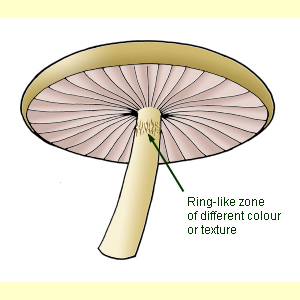
The partial veil, when present, connects the edge of the pileus to the stipe. The remains of the veil can only be observed in mature fruit-bodies where the pileus has expanded and the veil has broken. Partial veil remnants are most often about two-thirds to three-quarters of the way up the stipe from the base.
If the partial veil is still intact, see partial veil when young.
Choose this state if: a ring zone is present on the stipe surface. The ring zone is a narrow or broad band on the stipe surface which does not appreciably flare out from the surface, as does a membranous annulus. The ring zone is either the remnants of a cortina (cobwebby partial veil) or a collapsed thinly membranous partial veil. When the ring zone is formed from a cortina (as in most Cortinarius) the zone is usually fibrillose, with an uneven top and bottom edge. The fibrillose remains can be quite sparse, but often catch spores as they fall, and so is coloured as in the spore print. When a ring zone is formed from a membranous partial veil which is very thin, it may be a wide zone, or just a very narrow ridge. If possible, observe young fruit-bodies to see if a veil is present, and therefore some remains are expected.
